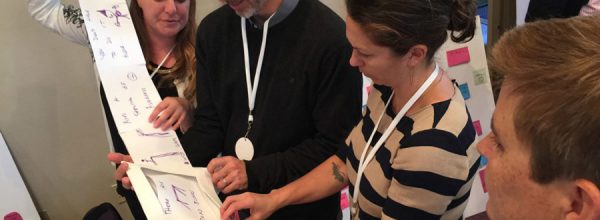Our spring 2017 meeting of the Safety Net Innovation Network brought a wide range of insights and perspectives on the topic of “clinics in the community.”
1. Anne Milgram was our keynote speaker. As the former attorney general for New Jersey and in her work as a scholar and activist, Anne advocates for and innovates around using smarter data and statistics to improve and reform the criminal justice system. In her talk she described the parallels and overlaps between this work and health care. This goes beyond shared problems and methods to shared people—67% of people frequently caught up in the criminal justice system are also frequent users of the healthcare system. Helping break the cycle for these patients may require new kinds of collaboration across sectors, and that will mean sharing data to see the “whole person” that exists beyond either a medical chart or a rap sheet. Anne also pointed out that we base our entire system of justice and punishment on the 4% of criminals who are violent offenders. Which makes us wonder: are we doing the same thing with healthcare?
2. Addressing social determinants is an opportunity to create our own human-centered measures of success. Kokua Kalihi Valley (KKV) in Hawaii has thought a lot about incorporating cultural elements into their metrics. They shared that they measured the success of one program in part by how many youth take their parents to visit a beautiful piece of land owned by the clinic, seeing that as a sign of an improving family dynamic. KKV also engages with the concept of dignity by using silverware instead of disposable utensils, to send the message that none of the people that eat there are disposable. This work helps us understand how success measures in SDOH work may not look like traditional medical metrics.
3. Some people in the safety net have asked CCI to recommend one SDOH screening tool and platform, so that organizations can be more on the same page and connect over shared tools. The tech gallery highlighted how complex the process of picking one platform can be. With all the overlap and competition in the health care tech space, does there need to be more pressure on platforms to collaborate and integrate their systems? All this is complicated by the varying levels of readiness of different health centers to implement similar technology (such as case management resource platforms), but there at least we can make some progress through knowledge sharing efforts like SNIN.
4. During the Myth of Plug and Play Technology, we heard from Hennepin County Medical Center and West County Medical Center about the realities of implementing two of the platforms highlighted in the tech gallery. While the technology partner is very critical, the even more challenging parts is to make sure the technology meets important needs of the end users and to continually measure and reflect on the impact it is making. We also learned how important it is to find the right tech partner who is flexible and interested in building a solution that adds value for all partners.
5. The Prevention Institute taught us about a useful collaboration multiplier tool that can help to engage a diverse group of stakeholders and align their drivers and needs towards solving a social problem. Establishing strong partnerships takes time and a lot of effort but unless this alignment around shared goals happens the collaboration will be not be fruitful.
6. Another interesting tool came out of the Trust & Doubt in Storytelling session with Nick Sung. It’s called doing Even-Overs. This is a construct to help teams prioritize and make decisions by asking if they would pursue one course even over another course. “I would invest in building a dynamic team EVEN OVER creating dynamic programs.” Try it!
7. Putting resources towards addressing social determinants is often justified using only economic incentives or potential cost savings. But the conversations during SNIN got us wondering: why don’t we discuss social services in the context of societal values outside of the safety net community?
8. Lots of good tips on brainstorming, from using the “5 Whys” framework get at a bite-sized problem via brainstorming to how pictures help to solidify ideas. Having people draw during a brainstorm session keeps everyone involved and engaged, and even if you think you can’t draw, you can create pictures using common symbols! A general rule to remember in brainstorming is that most of the time you get one good idea from 20, so ideation is a volume play.
9. As always in the safety net, the question of staffing looms large over efforts to address SDOH. The breakout session on how to support SDOH work through staffing offered insights we found useful, as many of the partner organizations stated that their programs are modeled after the Health Leads program. One clinic shared that their organization would like to work on SDOH but does not know how to effectively use their staff and volunteers to do so. Their big question was where the boundaries were being laid between each group. These are questions we will all be working on answering together in the coming years.
Find this useful or interesting? We’re constantly sharing stuff like this. Sign up to receive our newsletter to stay in the loop.









